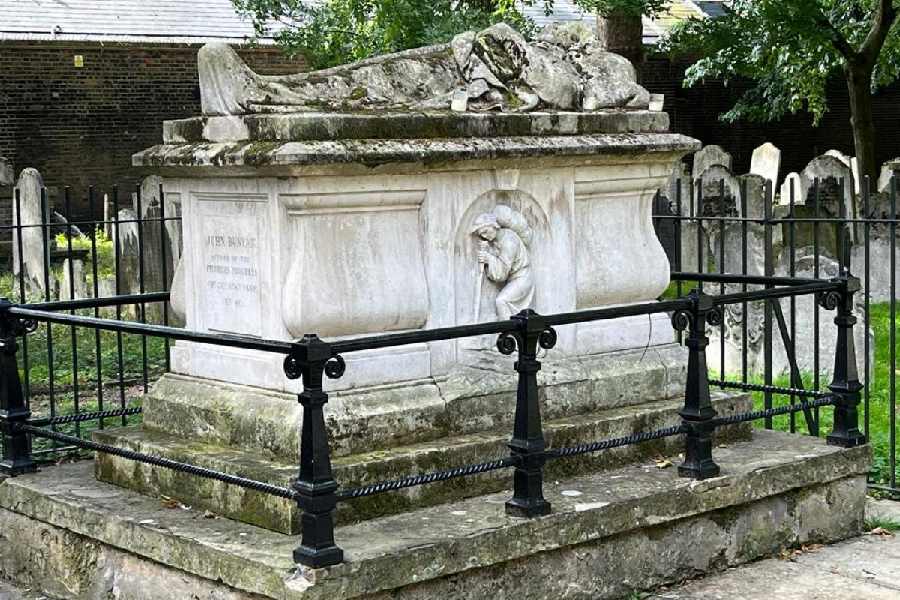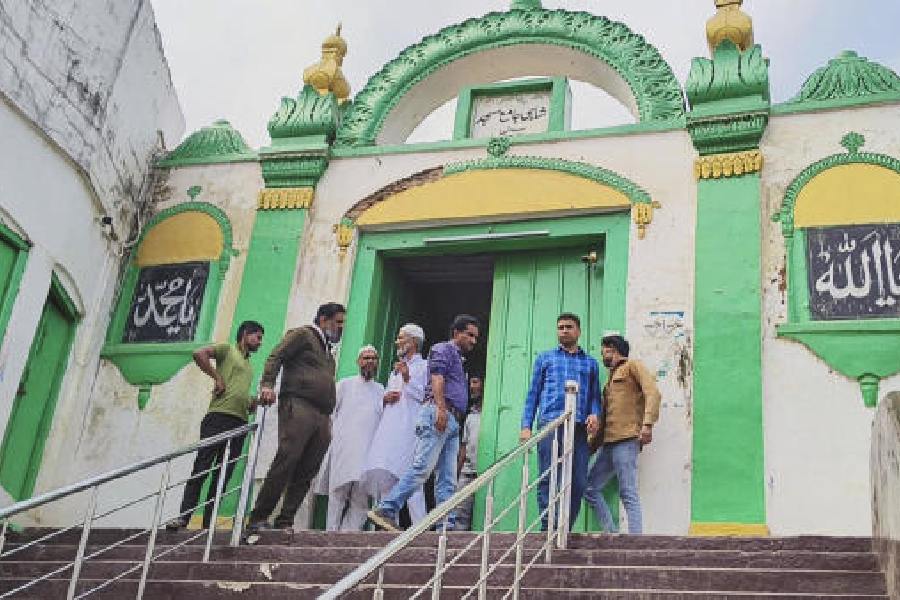The burial ground as a kind of archive of the past is not a familiar sight in India. Hindus cremate their dead while Muslims, with the notable exception of self-aggrandizing rulers, are buried in unmarked graves. Cemeteries in cities like Calcutta and Bombay bear witness to a mainly colonial past. In the great cities of the Christian world, though, the dead are literally with us.
Exploring the area around the Barbican in London, I came upon Bunhill Fields Burial Ground, which could have passed for one of London’s many city parks except for the fenced-off sections crowded with fading headstones. There was one, bigger and more clearly engraved than the others, standing in open ground that memorialised Dame Mary Page, wife of a baronet, who had died in 1728 at the age of 56. In a clear, serifed font, we were told that “In 67 months she was tap’d (tapped) 66 times had taken away 240 gallons of water without ever repining at her case or ever fearing the operation.” This was, clearly, an 18th-century example of oversharing but it did serve to bring dropsical Mary to life.
Walking through the burial ground was like meeting a Who’s Who of non-conformist writers, writers who belonged to Protestant congregations outside the established Anglican church. In one small stretch, I passed John Bunyan, author of the best-selling Christian parable, The Pilgrim’s Progress, which some critics claim is the first English novel, Daniel Defoe, spy, jailbird, businessman, author of Robinson Crusoe and Moll Flanders, and William Blake, prophet and poet. One reason for this concentration of talent was that all three of them belonged to non-conformist Christian sects and so couldn’t have been buried in Anglican churchyards. The prejudices of the Church of England made sure that dissenters flocked together even in death.
The interesting thing about the graves is the effort that has been made through the years to commemorate Bunyan, Defoe and Blake. Bunyan’s grave (picture) is marked by a recumbent statue of the writer commissioned in late-Victorian times, nearly two hundred years after he died. Similarly, the obelisk installed over Defoe’s grave was paid for by public subscription in 1870. The stone tablet over Blake’s grave, with lines of his verse inscribed on it in cursive, is a modern tribute. Writers fall in and out of fashion; they are kept alive by enthusiastic readers who find ways of commemorating them.
The other thing that strikes you is the role of printing and publishing in consolidating lives and reputations. There have been printed books in English since Caxton published the first one in 1473, so since the late-15th century. The reputations built by English literary figures since then are founded on the reach and power of the printed word. The Pilgrim’s Progress has never been out of print since it was first published in 1678. Inside a few years of Bunyan’s death, it had already sold a hundred thousand copies. For a late-seventeenth-century book, that is a staggering figure. Bunyan’s literary influence, the influence he had on writers from Dickens to Enid Blyton, is inseparable from the print culture that sustained him.
Defoe, who is a young contemporary of Bunyan, is even more completely constituted by print. Some bibliographers attribute more than three hundred works to him. Apart from his novels, he wrote A Journal of the Plague Year, where he reconstructed an account of the Great Plague, as well as a remarkable account of England on the eve of the Industrial Revolution, A Tour Thro’ the Whole Island of Great Britain. By the time Britain becomes an imperial power, Defoe is a canonical writer, ready to be exported to schoolchildren across the empire.
“Jerusalem” and “The Tyger” might be the limit of what the contemporary reader knows of Blake, but great galleries constantly exhibit his art, his place in the Romantic pantheon is secure, and academics like E.P. Thompson write books claiming him for this tradition or that, of radical dissent. Blake’s illuminated books, published between early 1790s and 1832, include an unfinished version of The Pilgrim’s Progress, a tribute from one dissenting Christian to another.
These are all modern writers in that their reputations were made in a world remade by print capitalism, Benedict Anderson’s term for the political economy of publishing. Instead of the long gestation into popularity or respectability characteristic of the pre-print world, post-Caxton England made it easier to reach large readerships relatively quickly. This new print culture encouraged the consolidation of reputation through scholarship: bibliographies, collected works, definitive editions, all contributed to the canonization of the modern writer.
Had Shakespeare lived and worked a hundred years earlier, the task of compiling a definitive edition of his plays would have been even harder in the absence of an established print culture.
One reason why South Asians don’t know their pre-colonial literary past with the same intimacy as the Western reader knows hers is the fact that printing and publishing arrived late and when they did, they came of age under the alienating aegis of the colonial State. The rupture with the past that was one of the inevitable consequences of colonialism meant that our Bunyans and Defoes weren’t always kept from neglect or obscurity by the invigorating tonic of print.
The responsibility for the neglect of India’s writers from her many literatures doesn’t rest with colonialism alone; some part of the blame must be borne by the republican State, its universities and its intellectual classes. The fact that there isn’t a single decent university press in India tells us something about how seriously our institutions of higher learning take their job of curating and publishing our intellectual culture.
Should a latter-day Defoe write A Journal of Our Plague Year detailing the horrors of the Covid lockdowns, people gasping for breath and dying during Delta, and the black farce of the IPL being played in Delhi against the backdrop of bodies being cremated on the streets of the city, will she find a commissioning editor with the nous to publish it and an intellectual culture with the resilience to keep a difficult book alive? In a couple of hundred years or so, we shall find out.
mukulkesavan@hotmail.com










